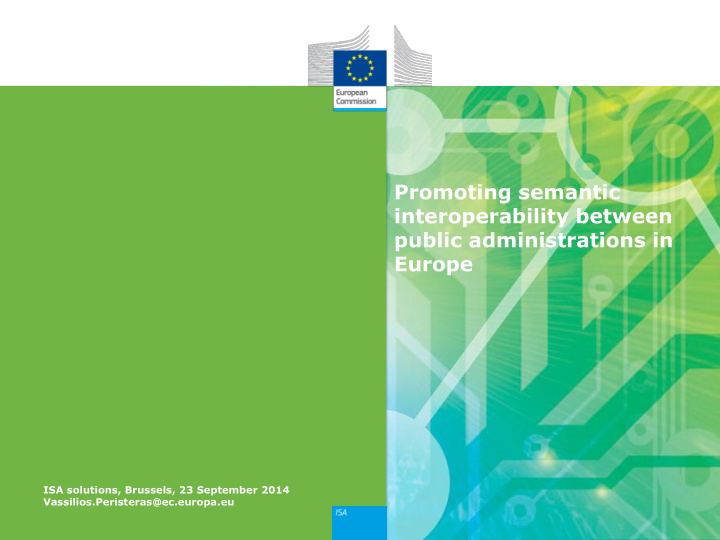



Promoting semantic interoperability between public administrations in Europe ISA solutions, Brussels, 23 September 2014 Vassilios.Peristeras@ec.europa.eu
What semantics is about? ISA work in semantics Scope of the visit
What semantics is about? ISA work in semantics Scope of the visit
How do we achieve technical interoperability?
What semantics is about? ISA work in semantics Scope of the visit
Making visible existing solutions
ADMS Click to edit Master title style • Using the same semantic standards promotes interoperability • By reusing what is available you save resources, you reduce risks, and you become more interoperable with others • A large number of semantic standards already exists 1
ADMS Click to edit Master title style • The existing solutions are scattered in numerous places and are very difficult to find – Several national initiatives to create repositories/libraries/catalogues of semantic standards (e.g. Germany, Denmark, Finland, Estonia…) – Standardization bodies and third party initiatives generate valuable and highly reusable specifications (e.g. OASIS, W3C, UN/CEFACT…) – Independent projects make available semantic standards to their own websites 1
ADMS Click to edit Master title style How could we promote the visibility and reuse of existing semantic standards at the European level? 1
ADMS How could we promote the reuse of existing Click to edit Master title style semantic standards at the European level? … by agreeing on a common language (template) to describe semantic standards … creating a yellow page infrastructure with standards descriptions and links to the actual standards 1
ADMS C ommon template ( metadata ) for describing semantic standards Click to edit Master title style Asset Description Metadata Schema (ADMS) May 2012: ADMS endorsed by the EU member states (ISA Coordination Group) 1
ADMS ADMS implementation Click to edit Master title style ADMS-based federation of Catalogue of semantic semantic standards repositories standards • Semantic standards are described using ADMS • Features simple and advanced search of semantic standards • 2000+ semantic standards from 25 repositories are currently searchable through Joinup Since January 2013 1
ADMS European Federated Interoperability Repository Click to edit Master title style (EFIR) ADMS-based repository of any Catalogue of interoperability type of interoperability solution solutions • Interoperability solutions are described using ADMS • Features simple and advanced search of interoperability solutions • Semantic and technical standards, open source software, reusable services By end 2014 1
Click to edit Master title style Making visible existing solutions Establishing agreements on basic semantics
Core Vocabularies Click to edit Master title style "…What has been discovered over the years is that there are a number of (information) structures that are universal and applicable to all kinds of organizations, both private and public. There are four fundamental categories: People and Organizations, Geography, Physical Resources and Activities and Events" David Hay, Describing the World: Data Patterns 1
Core Vocabularies Core vocabularies Click to edit Master title style Simplified, re-usable, generic and extensible data models that capture the fundamental characteristics of a data entity in a context-neutral fashion. CORE PUBLIC SERVICE VOCABULARY 1
Core Vocabularies Usage Click to edit Master title style - New systems: As default starting points for data modeling - Existing systems: - As reference data models for integration and information sharing - As export specifications for publishing open data CORE PUBLIC SERVICE VOCABULARY 2
Click to edit Master title style Making visible existing solutions Establishing agreements on basic semantics Improving interoperability of open data
Open Data: the European Perspective Click to edit Master title style 150+ Existing OGD Portal
Open Data: the European Perspective Click to edit Master title style Limited Limited Different accessibility reuse of metadata and lack of open vocabularies awareness datasets How can I find and combine public data from various sources?
Open Data: the European Perspective Click to edit Master title style DCAT APPLICATION PROFILE FOR E UROPEAN DAT A PORT ALS The DCAT Application profile (DCAT-AP) is a common template to describe public sector datasets and data catalogs
Open Data: the European Perspective Click to edit Master title style 2014-2020: progressive 2013:pilot implementation of a pan-European as one of the CEF Open Data Portal (Connecting Europe Facility) Infrastructures (Open Data)
Click to edit Master title style Making visible existing solutions Establishing agreements on basic semantics Improving interoperability of open data Raising awareness on semantic Communities Studies Visits interoperability and metadata management
Recommendations Develop a national catalogue of core data standards (I) 1. Identify highly reusable information entities which remain relevant across different government domain - Examples from DK, USA, DE, JP: person, business, locations - Rule of thumb: this data is stored in base registries 2. Model this information to create generic data models and define reference data values. Use standard modeling approaches (e.g. UML, XML, RDF) and reuse existing content standards whenever possible (e.g. ISA Core Vocabularies, UBL) - Example: the OSLO data standard for local authorities 3. Develop and maintain a library of these core data standards. Promote this library as an authoritative source of core data elements (objects, properties, values) - Examples: Germany-KOSIT, USA-NIEM, Japan-Core Vocabularies
Recommendations Develop a national catalogue of core data standards (II) 4. Develop tools to a) allow easy reuse of the models published in the library, b) validate compliance with the core library - Examples: Germany-KOSIT, USA-NIEM 5. Provide space for organic growth of domain specific libraries around the core library. Allow domain-specific communities to contribute and share their (core library-compliant) models. - Examples: Germany-KOSIT, USA-NIEM 6. Document your data models using ADMS and make descriptions available on the web. Joinup federates this content. - Examples: 23 repositories already have used ADMS to describe their assets including Germany - Xrepository, Estonia - RIHA, the Netherlands - Dutch Standardisation Forum, Belgium - Belgian Interoperability Catalogue, Denmark - Digitalisér.dk. 7. Develop a national government metadata and standards policy (e.g. “comply or explain ”)
? Questions
Recommend
More recommend